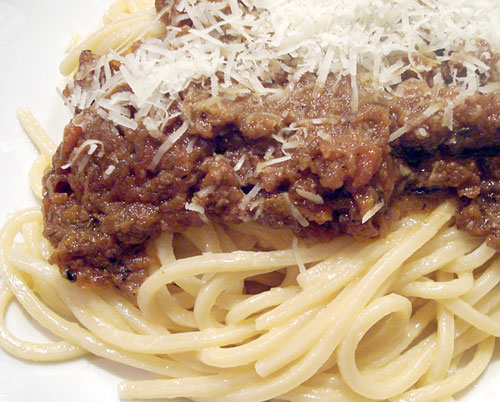
I love pasta in many guises, but when it comes to ultimate Comfort Pasta, there is nothing that compares to a spaghetti bolognese. By spaghetti bolognese, I mean spaghetti topped with a rich, ground-meat and tomato based sauce. No fancy ragu or such. I don't think it's that authentically Italian, but I don't really care. It's one of my favorite cool-weather dinners.
Once upon a time, I had what I thought was a perfect recipe for spaghetti bolognese. Then, about a year ago I lost my way. After a year of bewilderingly off-target bolognese, I've found my way back.
I blame Heston Blumenthal for messing with my head. (Disclaimer: I am otherwise a big fan of Mr. Blumenthal.) Last year, he tackled spaghetti bolognese on his In Search of Perfection television series (and in the book of course), and came up with a "perfect" version. The perfect Blumenthal version of spaghetti bolognese is, naturally, extremely complicated, but compared to the other "perfect" versions of various popular dishes it seemed to be the most doable. So, we (note the plural: it required a team effort) tackled it, piece by piece. It does help in life to have an almost equally food-obsessive partner for such quests.
It took us 3 full days to accomplish, starting from the pre-ordering of the meaty oxtails at the butcher counter (it's not a commonly used cut here), finding the perfect spaghetti, ripe tomatoes in December (yes, I know) and the final slow cooking of the sauce. And the result?
It was good, yes, but perfect? Neither of us was sure. But yet it had flashes of something great in there; the meatiness of the gelatinous oxtail, the unctuous richness. So, we embarked on a long journey of trying to tweak that recipe. We tried different meat combinations. (Turkey is a definite no.) We experimented with bacon, chorizo, various sausages, salami. We tried less or more of the vegetables, canned tomatoes alone or fresh alone.
All were interesting, but I still felt off kilter. Then, the other day I made bolognese more or the way I had made it for years until the Blumenthal experiments - and, it was just about perfect.
Mind you, it's probably because my criteria for a perfect bolognese are different from the great chef's, as I explain below. And some of the ideas gleaned from the Blumenthal version and the ensuing experiments did creep in, making the sauce even better. In any case, I'm now happy that this is my Perfect Spaghetti Bolognese. I can now move on to perfecting other things.
Filed under:
dinner winter sauce pasta favorites italian meat